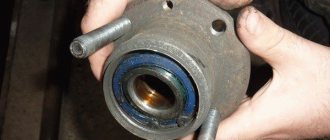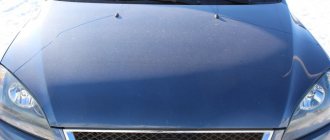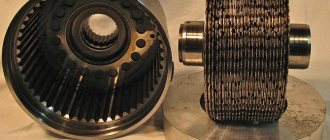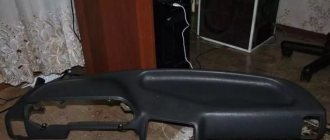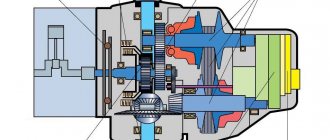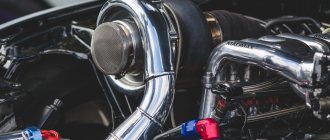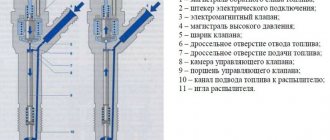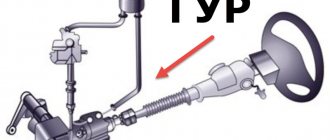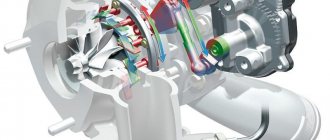Torsion bar suspension has been used in automobile development for approximately 80 years. It was first used on Citroen cars back in the 30s of the twentieth century. A little later, this design attracted the interest of the Germans, who implemented the idea into Volkswagen Beetle cars. The domestic automobile industry lagged behind in this regard, and for the first time this type of suspension was used on the Zaporozhets car.
Nowadays, the principle of torsion bar suspension is used in most cars. It has gained great popularity because its design is very simple and the cost is much lower than other options.
Application
Main article: Torsion bar suspension
- Pendulums with torsion bar suspension;
- Torsion return springs in measuring instruments;
- Suspension of armored vehicles and cars (for example, rear-engine ZAZ and passenger cars ZIL, LuAZ, front axle Zaporozhets, as well as many French models of the 1950s - 1970s, almost all Chrysler cars from the late 1950s to the 1980s, cars Mazda (Demio, Familia, Capella) of the late 1990s, Alfa Romeo, Suzuki SX4, etc.);
- Shafts of a certain design to smooth out impacts;
- In multi-threaded gearboxes for equalizing torques between parallel gears;
- Some types of antique throwing machines used torsion bars made of organic fibers;
- For balancing heavy opening structural elements (armored hatch cover in armored vehicles, tank transmission roof, KamAZ vehicle cabin, trunk lid of Volga, Zhiguli, Moskvich vehicles, sectional doors, freezer door spring of Minsk-10 refrigerators " etc);
- Torsion bars are used to connect the shaft and rings in the design of dynamically adjustable gyroscopes
The principle of operation of torsion bar suspension
Diagram of the torsion bar suspension of the Hummer H2: 1. Wheel hub; 2. Drive shaft; 3. Lower wishbone; 4. Upper wishbone; 5. Shock absorber; 6. Anti-roll bar; 7 Front differential; 8. Longitudinal torsion bar; 9. Subframe
The operating principle of a torsion bar suspension is quite simple. Through a splined connection, one end of the torsion bar is connected to the wheel hub by means of a suspension arm, and the other is fixed to the car frame. The lever axis and the torsion bar twist axis are located in the same plane. When the wheel moves vertically, the torsion bar twists, which causes a springing effect.
The tension is maintained during the period of action of the lifting and lowering forces. In this case, the load is softened and redistributed, which is directed to the body, which helps protect the car from high-rigidity impacts, including impacts.
The cessation of external influence is accompanied by the return of the wheel to its normal position. This occurs as a result of the torsion bar unwinding. The mechanism resembles the operation of a spring, but the efficiency of the torsion bar is noticeably higher.
Calculations
A rod used as an elastic element that works to twist is called a torsion bar
.
Tangential stresses τ r {\displaystyle \tau _{r}} arising under torsion conditions are determined by the formula: τ r = T r J 0 {\displaystyle \tau _{r}={Tr \over J_{0}} } ,
where r
— distance from the axis of torsion.
It is obvious that the shear stress reaches its greatest value on the shaft surface at rmax = R {\displaystyle r_{max}=R} and at maximum torque M max {\displaystyle M_{max}} , that is
τ max = T max RJ 0 = T max W p {\displaystyle \tau _{max}={T_{max}R \over J_{0}}={\frac {T_{max}}{W_{p} }}} ,
where Wp
- polar moment of resistance.
This makes it possible to write the torsional strength condition in the following form:
τ max = T max W p ≤ [ τ ] {\displaystyle \tau _{max}={\frac {T_{max}}{W_{p}}}\leq [\tau ]} .
Using this condition, you can either use the known force factors that create the torque T to find the polar moment of resistance and then, depending on a particular shape, find the dimensions of the section, or vice versa - knowing the dimensions of the section, you can calculate the largest value of the torque, which can be allowed in the section, which, in turn, will allow us to find the permissible values of external loads.
τ = M t I 0 V ≤ τ adm {\displaystyle \tau ={\frac {Mt}{\frac {I_{0}}{V}}}\leq {\tau }_{adm}} ,
where τ = 16 M t π d 3 {\displaystyle \tau ={\frac {16\,Mt}{\pi d^{3}}}} (for a solid shaft)
or τ = 16 de M t π ( de 4 − di 4 ) {\displaystyle \tau ={\frac {16\,d_{e}\,Mt}{\pi (d_{e}^{4}-d_ {i}^{4})}}} (for hollow shaft)
What is torsion bar suspension
The basic element of a torsion bar suspension is a torsion bar (from the French torsion - twisting), an element made in the form of a cylindrical rod of increased elasticity, working to twist in one direction. The shape of the torsion bar is not subject to a single standard, so in cross section it is mainly square or round. Another less common option is a plate torsion bar, which has a multilayer structure, also designed for torsion provided by the joint operation of several plates.
In order to increase torsional springiness, the steel used in the production of torsion bars undergoes complex multi-stage heat treatment. Thanks to this, intense torsional stresses and significant twist angles do not create problems for the suspension. Both ends of the torsion bar are movable, which is achieved through the use of bearings and splined joints to accommodate changes caused by workloads.
The torsion beam located under the body can occupy both longitudinal and transverse positions. The longitudinal version is found mainly in trucks, where the chassis is constantly subject to significant loads. Transverse torsion bar suspension is installed on passenger cars, especially rear-wheel drive ones.
Torsion shafts have different thicknesses, which affects the performance and softness of the suspension. To avoid rusting, the torsion bar is protected with durable anti-corrosion paint or rubberized.
Independent suspension
Independent suspension is different in that the wheels of one axle are not connected to each other and the movement of one of them does not have any effect on the other. In fact, in this type, each wheel has its own set of components - elastic, damping, guide. These two sets practically do not interact with each other.
MacPherson struts
Several types of independent suspension have been developed. One of the most popular types is the MacPherson suspension (aka “swinging candle”).
The peculiarity of this type lies in the use of the so-called shock-absorbing strut, which simultaneously performs three functions. The strut includes both a shock absorber and a spring. At the bottom, this component of the suspension is attached to the wheel hub, and at the top, through supports, it is attached to the body, so in addition to absorbing and damping vibrations, it also secures the wheel.
MacPherson gas-oil strut device
The design also contains another component of the guide system - transverse levers, the task of which, in addition to providing a movable connection of the wheel with the body, is also to prevent its longitudinal movement.
To combat body roll while driving, the suspension design uses another element - an anti-roll bar, which is the only connecting link between the suspensions of two wheels of the same axle. In essence, this element is a torsion bar and the principle of its operation is based on the occurrence of a counteracting force during twisting.
MacPherson strut suspension is one of the most common and can be used on both the front and rear axles.
It is distinguished by its relatively compact size, simplicity of design and reliability, for which it has gained popularity. Its disadvantage is that the camber angle changes when the wheel travels significantly relative to the body.
Lever type
Lever independent suspensions are also a fairly common option used on cars. This type is divided into two types - double wishbone and multi-link suspension.
The design of the double wishbone suspension is made in such a way that the shock absorber strut performs only its direct tasks - dampening vibrations. The wheel mount rests entirely on the control system, which consists of two wishbones (upper and lower).
Double wishbone suspension
The levers used are A-shaped, which ensures reliable retention of the wheel from longitudinal movement. In addition, they are of different lengths (the upper one is shorter), due to which even with significant movements of the wheel relative to the body, the camber angle does not change.
Unlike the McPherson, the double-wishbone suspension is larger and requires more metal, although a slightly larger number of components does not affect reliability, but it is somewhat more difficult to maintain.
The multi-link type is essentially a modified double-wishbone suspension. Instead of two A-frames, its design uses up to 10 transverse and longitudinal arms.
Multi-link suspension
This design solution has a positive effect on the smoothness and controllability of the car, maintaining the wheel angles during suspension operation, but at the same time it is more expensive and difficult to maintain. Because of this, in terms of applicability it is inferior to MacPherson struts and the double-lever type. It can be found on more expensive cars.
Where is torsion bar suspension used?
The use of such a suspension was widely practiced during the Second World War. This applied to tanks and other armored vehicles. After such testing, the technology was adopted by all leading European automakers and US companies. Torsion bars first appeared on the front suspension in 1961 in the Jaguar E-Type. In the USSR, in addition to the Cossacks, they were integrated into ZILs and LUAZs. Later, due to their specificity, torsion bars ceased to be used in passenger transport. Although some SUVs and trucks from manufacturers such as GM, Ford, Dodge Mitsubishi are still produced with suspension based on torsion bars.
Despite its more than 80-year history, torsion bars have been and are used in the production of several types of suspensions:
- on trailing arms - was used in the rear suspension of small cars, but is no longer relevant today;
- independent double wishbone system - currently successfully supports the performance of some SUV models;
- semi-independent (semi-independent) – widely used in passenger vehicles of classes “A”, “B” and “C”.
Application of the torsion model
Car suspension: types, structure and principle of operation
The torsion beam can be positioned longitudinally and transversely. The longitudinal arrangement is used on large, heavy trucks. Passenger cars use a transverse arrangement, usually with rear-wheel drive.
In these two cases, the mechanism is designed to ensure a smooth ride, regulate roll when turning, ensure optimal damping of vibrations of the wheels and body, and reduce vibrations of the steered wheels.
For some vehicles, torsion bar suspension is used for automatic leveling using a motor that tightens the beams for additional rigidity, depending on the speed and condition of the road surface.
The height-adjustable design can be used when changing wheels. This is when the vehicle is raised with the help of three wheels, and the 4th is raised with the help of a jack. The main advantage of this type of suspension is considered to be durability, ease of height adjustment, and compactness in the width of the vehicle.
It takes up much less space than spring suspensions. Of course, the torsion bar configuration is easy to operate and also easy to maintain.
A little bit of history
Torsion bar suspension for cars has been used for a long time. It was first used on the Citroen Traction Avant. Then German manufacturers released the famous Volkswagen Beetle, where the main part was the torsion bar. This design has gained wide popularity largely due to its simple manufacturing design and compact size.
Later they began to use it on the Zaporozhets car, where it acted as a front suspension with two square torsion bars. Therefore, it should not be surprising that this design is especially popular today.
car suspension on double trailing arms
This suspension has two trailing arms on each side. As a rule, such a suspension was used on the front axle of relatively low-speed rear-engine cars - typical examples of its use are the Volkswagen Beetle and the first generations of the Volkswagen Transporter, early models of Porsche sports cars, as well as the S-3D and Zaporozhets sidecars.
All of them had essentially a common design (the so-called “Porsche system”, in honor of the inventor) - transverse torsion shafts located one above the other were used as elastic elements, connecting a pair of levers, and the torsion bars were enclosed in pipes that formed the cross member of the suspension (in later models “Zaporozhets”, in addition to torsion bars, cylindrical coil springs located around the shock absorbers were also used as additional elastic elements).
Volkswagen Beetle
The main advantage of such a suspension is its greater compactness in the longitudinal and vertical directions. In addition, the suspension cross member is located far ahead of the axis of the front wheels, making it possible to move the cabin forward far forward, placing the legs of the driver and front passenger between the arches of the front wheels, which made it possible to significantly reduce the length of the rear-engined car. At the same time, however, the trunk located in front turned out to be very modest in volume, precisely because of the suspension cross member placed far forward.
From the point of view of kinematics, this suspension is imperfect: it undergoes, although smaller compared to single trailing arms, but still significant changes in the wheelbase during rebound and compression strokes, and there is also a strong change in wheel camber during body roll. It should be added that the levers in it must absorb large bending and torsional loads from both vertical and lateral forces, which makes them quite massive.
Torsion bar suspension: good for both a tank and a passenger car
Greetings, my dear car enthusiasts!
In this article we have to find out: what a torsion bar suspension is, the operating principle of this design and its features. If you dig deeper into history, you will find that torsion bar suspension was successfully used in the early, middle and late twentieth centuries, and is also often found today.
Having undergone a lot of modernizations and improvements during its existence, it has become a classic, and you can see it not only on passenger cars, but even as a tank suspension.
What is a torsion bar?
In fact, the design of a torsion bar suspension can be different, which we will talk about later. But be that as it may, the key element of the system is the so-called torsion bar (elastic element), hence the name.
What is this? Essentially, it is a metal rod that can have either a round or square cross-section.
The main property of a torsion bar is its high elasticity when twisted, that is, if you take such a rod by its two ends and twist it in opposite directions, it will naturally spring back and try to return to its original state. This property is the basis for the operation of torsion bar suspensions.
Semi-independent suspension
This variety occupies a special place among suspensions in which the elastic element is a torsion bar. It is an intermediate link between independent and dependent suspensions, which is why it is called semi-independent. It has found wide application among many cars from “A” to “C” class. Its device looks like this. The trailing arms, located one on each side, are connected to each other by a torsion beam. One end of each of them is attached to the car body, and the other to the wheel hub.
The principle of its operation is based on the shape of the elastic element. The beam has a U-shaped cross-section, due to which it resists bending well, but easily twists. Therefore, the wheels are able to move in a vertical plane without depending on each other. The diagram of the torsion beam is shown in the photo.
What type of suspension is called torsion bar?
Torsion
(from the French
torsion
- twisting, torsion) - a rod that works to twist and performs the functions of a spring. It allows for high torsional stresses and significant twist angles of several tens of degrees. Made from spring steel with subsequent heat treatment.
Torsion bar suspension is the chassis of a car, which is equipped with torsion bars as elastic elements.
Torsion bars are more often rods of round and square cross-section or, which is less common, made up of several plates of spring steel, like springs, but working to twist. Round rods at one end usually have a splined knurl for attaching them to levers, and for attaching to a supporting element (frame or body), the other end has either splines or a profile that differs from the round one. For more reliable fastening, the spline knurled section is usually made with a larger diameter than that of the main rod. Torsion bar suspension can be independent or semi-independent, as in the photo. Independent torsion bar suspension is most often used at the front of the car. Semi-independent torsion bar suspension (torsion beam) is often found in the rear of front-wheel drive cars. The operating principle of a torsion bar is the same as a spring. Only the spring stores energy by compressing, and the torsion bar by twisting.
Kinds
Torsion bar suspensions come in several types:
1. Torsion bar with double wishbones.
The peculiarity here is that the torsion bar is parallel to the car body. This feature allows you to accurately adjust the suspension. The design features of such a suspension include the presence of special fasteners:
- on one side - to the transverse lever (located at the bottom of the car) or to the lever located on the opposite side;
- on the other hand - to the vehicle body.
This type of torsion bar is most in demand on cars with a high level of cross-country ability. As practice shows, most torsion bars with trailing arms are installed on cars from Japanese and American manufacturers.
2. Torsion bar with trailing arms. The main difference between this design is the combination of torsion bars with trailing arms. As a result, they are no longer located parallel, but perpendicular to the body part. This type of suspension has become most popular in passenger cars.
3. Torsion bar with linked trailing arms
In recent years, special attention has been paid to this design. A special feature is the unique design of the guide unit, the function of which is taken over by several trailing arms
The latter are attached to the wheel hubs on one side, and to the car body on the other. The beam itself has an unusual design, having a U-shaped cross-section.
The feature described above is a guarantee of suspension rigidity and bending stability with almost complete absence of torsion. Some experts consider this feature to be a flaw, but in practice this was intended. Thanks to these features, the wheels can move in any direction. Moreover, they are in no way dependent on each other.
The main elements of such structures are hinges (metal and rubber), a transverse torsion bar, a coil spring, a wheel hub, a shock absorber and a trailing arm.
Advantages and disadvantages
Regardless of the type of torsion bar suspension used, its presence helps the car effectively cope with many tasks:
- smooth ride;
- good absorption of frame and wheel vibrations;
- stabilization of the drive wheel pair;
- possibility of adjusting the degree of suspension stiffness;
- normal controllability when rolling.
If we take into account the ease of operation and maintenance, we can separately highlight that to bring the suspension back to normal, in many cases, only a wrench is sufficient to sufficiently tighten the mounting bolts. In addition, you should take into account other positive aspects of torsion bar suspensions:
- compact size and light weight;
- no installation difficulties;
- trouble-free adjustment of ground clearance that does not require changes to the suspension;
- long working life and maintainability.
As for the disadvantages of torsion bar suspension, here's what you need to focus on:
- not necessary, but shaking may occur, especially in the back seat, which is associated with rigid fastening, resulting in the transmission of strong vibrations;
- the appearance of noise, which is explained by the difficulty of protecting the body from vibrations and is also due to rigid fastening;
- there is a possibility of oversteer, especially with small car sizes;
- The service life of the needle bearings located at the junction of the torsion beam and levers is limited to 70 thousand kilometers.
In comparison with automobile industry products with other types of suspension, purchasing a car with torsion bars, as a rule, is not so expensive, and the costs of maintaining it in order cannot be called excessive.

